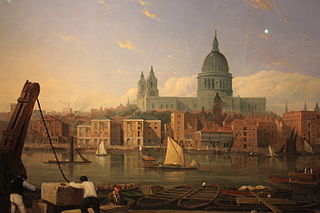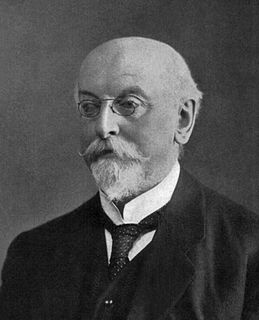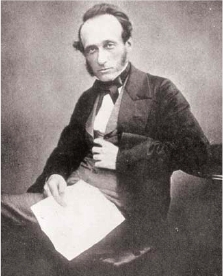Related Research Articles
John StenhouseFRS FRSE FIC FCS was a Scottish chemist. In 1854, he invented one of the first practical respirators.

Théophile-Jules Pelouze was a French chemist.

August Wilhelm von Hofmann was a German chemist who made considerable contributions to organic chemistry. His research on aniline helped lay the basis of the aniline-dye industry, and his research on coal tar laid the groundwork for his student Charles Mansfield's practical methods for extracting benzene and toluene and converting them into nitro compounds and amines. Hofmann's discoveries include formaldehyde, hydrazobenzene, the isonitriles, and allyl alcohol. He prepared three ethylamines and tetraethylammonium compounds and established their structural relationship to ammonia.

Blaydon is a town in the North East of England in the Metropolitan Borough of Gateshead - historically in County Durham. Blaydon, and neighbouring Winlaton, which Blaydon is now contiguous with, form the postal town of Blaydon-on-Tyne. The Blaydon/Winlaton resident population in 2011 was 13,896.

Ryton is a small town in the Metropolitan Borough of Gateshead, Tyne and Wear, England, 5.8 miles west of Newcastle upon Tyne. Historically in County Durham, it was incorporated into the metropolitan county of Tyne and Wear and the Borough of Gateshead in 1974. In 2011, the population of the Ryton, Crookhill and Stella ward was 8,146.

John Lawrence Smith was an American chemist, born in Louisville, Kentucky, and educated at the University of Virginia, the Medical College of South Carolina, in Germany under Liebig, and in Paris under Pelouze. In 1844 he began the practice of medicine at Charleston and established the Medical and Surgical Journal of South Carolina. Between 1846 and 1850, he investigated the mineral resources of Turkey, for Turkey's government, and he discovered deposits of coal, chrome ore, and the famous emery deposits of Naxos. In Turkey he also discovered liebigite, and named it after his German teacher Liebig.
Edmund Davy FRS was a professor of Chemistry at the Royal Cork Institution from 1813 and professor of chemistry at the Royal Dublin Society from 1826. He discovered acetylene, as it was later named by Marcellin Berthelot. He was also an original member of the Chemical Society, and a member of the Royal Irish Academy.

Thomas Sopwith FRS was an English mining engineer, teacher of geology and local historian.

George Stephenson built a number of experimental steam locomotives to work in the Killingworth Colliery between 1814 and 1826.

Thomas Miles Richardson (1784–1848) was an English landscape-painter.

The North of England Institute of Mining and Mechanical Engineers (NEIMME), commonly known as The Mining Institute, is a British organisation dedicated to the research and preservation of knowledge relating to mining and mechanical engineering. Founded in 1852, the Institute, in Newcastle upon Tyne, possesses one of the largest collections of such mining information in the world. Its library, named after the first President Nicholas Wood contains more than twenty thousand volumes of technical literature, in the fields of mining, geology, mechanical engineering, government blue books, mine rescue, mineralogy, mineral chemistry, mining statistics, mining law, seismology and other related topics.

Losh, Wilson and Bell, later Bells, Goodman, then Bells, Lightfoot and finally Bell Brothers, was a leading Northeast England manufacturing company, founded in 1809 by the partners William Losh, Thomas Wilson, and Thomas Bell.
Dr Robert Dundas Thomson FRSE FRS FRCP FCS was a British physician and chemist and a pioneer of public sanitation. He worked as an academic, medical officer of health and author.
Robert Nunn, better known as Bobby Nunn, was an English concert-hall songwriter and performer in the 19th century. His most famous song is possibly "The Fiery Clock Fyece". A roof slater by trade, after suffering a serious injury that cost him his vision, he was unable to continue employment, taking up music to support his wife and three children.

Lucius Trant O'Shea was a British chemist and mining engineer; between 1908 and 1920 he acted as the general secretary of the Institution of Mining Engineers of Great Britain.
Dr Edmund Ronalds FCS FRSE was an English academic and industrial chemist. He was co-author of a seminal series of books on chemical technology that helped begin university teaching of chemical applications for industry, and was a pioneer in the incorporation of advanced research into a manufacturing firm.

The Newcastle & Carlisle Railway (N&CR) was an English railway company formed in 1825 that built a line from Newcastle upon Tyne on Britain's east coast, to Carlisle, on the west coast. The railway began operating mineral trains in 1834 between Blaydon and Hexham, and passengers were carried for the first time the following year. The rest of the line opened in stages, completing a through route between Carlisle and Gateshead, south of the River Tyne in 1837. The directors repeatedly changed their intentions for the route at the eastern end of the line, but finally a line was opened from Scotswood to a Newcastle terminal in 1839. That line was extended twice, reaching Newcastle Central station in 1851.
Thomas Young Hall was an internationally acclaimed mining engineer and coal mine owner. A native of Tyneside, he was a well-known figure in Newcastle in the mid-nineteenth century. Born in Greenside on 25 October 1802, his father, James Hall, was a mining engineer, manager of the Folly Pitt, and agent to several leading coal mine owners including the Dunns, G. Silvertop, Capt. Blackett, W. P. Wrightson, P. E. Townley, and John Buddle.

Robert Warington FRS was an English chemist considered the driving force behind the creation of the world's first enduring chemistry society, The Chemical Society of London, which later became the Royal Society of Chemistry.
References
- . Dictionary of National Biography . London: Smith, Elder & Co. 1885–1900.